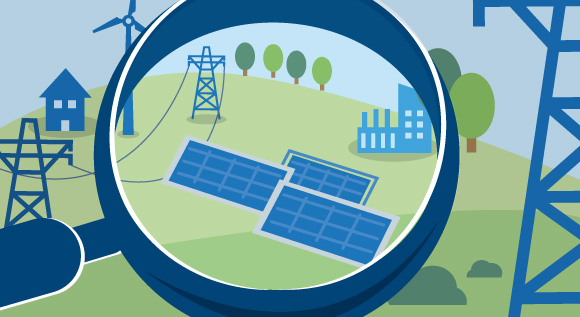What exactly is CCS?
Even with the best technology, some CO2 emissions will be hard to abate or unavoidable. Using CCS, carbon capture and storage, these emissions could, however, be stored underground for thousands of years. Read on to take a trip to depths of up to 3,000 metres.
 © Federal Ministry for Economic Affairs and Climate Action
© Federal Ministry for Economic Affairs and Climate ActionHarmful CO2 is to be securely and permanently stored in deep geological rock formations
Germany is aiming to be climate neutral by 2045, as stated in the Federal Climate Change Act. For this to happen, the emission of harmful greenhouse gases like CO2 has to be prevented wherever possible. In spite of all efforts, there will, however, be emissions that are hard to abate or unavoidable using the available technologies, for example, in some branches of industry and waste management. CCS technologies should therefore be developed further.
How CO2 emissions that are hard to abate or unavoidable are to be stored in the future
This is shown by various climate neutrality studies that were evaluated for the 2nd evaluation report on the Carbon Dioxide Storage Act, which was adopted by the Federal Government at the end of 2022. The report presents advances in technology and the latest scientific findings, and highlights potential fields of action considered necessary for the achieving of climate targets. The potential contribution by CCS is to also be considered in this context.
Instead of going high up into the atmosphere, in the future CO2 emissions that are hard to abate or unavoidable will go down into the rocky underground. This is because captured carbon can be securely and permanently stored underneath the Earth’s surface, in deep geological rock formations (between 800 and 3,000 metres below the surface).
How underground CO2 storage works
CCS is a process chain made up of three procedural steps: carbon capture, carbon transport and carbon storage. First, technology is used to capture CO2 at large point sources to keep it out of the atmosphere and thus mitigate climate change. In its transportation, the CO2 is, for instance, channelled via a pipeline from the point source to the storage site and finally, injected into suitable rock formations through boreholes.
Geological carbon storage has been undertaken for decades worldwide – from small pilot projects, right up to large industrial projects and under various geological conditions. Suitable geological storage options include, for example, depleted oil and natural gas fields and rock formations bearing salt water (saline aquifers). Large volumes of CO2 can be injected into these storage capacities.
This is where the largest storage capacities are found
The as yet only carbon storage project in Germany is located west of Berlin at the pilot site, Ketzin. From June 2008 until August 2013, a total of around 67,000 tonnes of CO2 was stored in a saline aquifer at depths of 630 to 650 metres. The large storage capacities in Germany and Europe are located beneath the North Sea, more specifically the Norwegian part of the North Sea, where CO2 has been securely injected and stored on a large scale since 1996 as part of the Sleipner Project. The large-scale Norwegian project Northern Lights is currently also being developed here. It will soon be the first project on an industrial scale to realise the entire process chain.
On the basis of the evaluation report on the Carbon Dioxide Storage Act, this year the Federal Government wants to draw up a carbon management strategy, which, accompanied by extensive stakeholder dialogue, is to outline potential fields of application for CCS in Germany. Expanding renewable energy, increasing energy efficiency and the efficient use of resources remain the top priorities for reducing greenhouse gas emissions.

